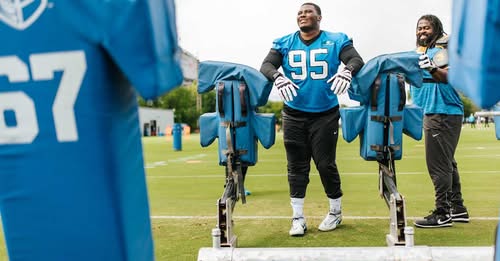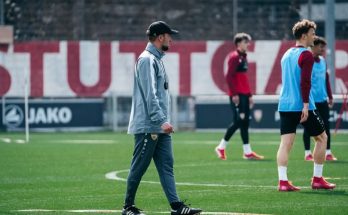When Derrick Brown was carted off the field during a late-season game, many feared the worst. The Carolina Panthers’ defensive tackle had become a cornerstone of the team’s front line, an immovable object capable of wrecking opposing game plans with his combination of power, intelligence, and relentless motor. But this time, even Brown’s towering frame seemed vulnerable. What followed was a harrowing medical journey that left the 6-foot-5, 320-pound star not just sidelined, but having to relearn how to walk.
The injury itself was gruesome, though the Panthers never released full details. Sources close to the team described it as a “significant lower body trauma” involving extensive ligament and nerve damage. The aftermath forced Brown into a wheelchair for nearly two months. For an elite NFL athlete at the peak of his powers, the sudden dependence on others for the simplest movements was a humbling, even crushing, experience. Brown, however, was never one to wallow. Instead, he faced this new challenge the same way he battles offensive linemen—head on, with unshakable resolve.
Learning to walk again was not just a physical battle but a mental crucible. The early days were the hardest. Every minor step on a treadmill felt like climbing Everest. Pain was constant, and progress often slow. But Brown, who once said that football had taught him how to embrace adversity, applied that same discipline to his rehab. “There were days I didn’t want to get out of bed,” he admitted during a recent interview. “But I kept telling myself, ‘You walked onto that field like a warrior. Now you walk off it the same way—even if it takes everything you have.’”
The Panthers’ medical staff, physical therapists, and trainers rallied around Brown with a commitment that matched his own. His rehab became the heartbeat of the team facility during the offseason. Younger players would stop by the training room just to watch him work. His determination became contagious, a daily reminder that greatness isn’t just built on stats or Pro Bowl nods—it’s forged in struggle.
While Brown waged war against his own body, something remarkable was happening with the Panthers’ defensive line. Often seen as one of the league’s underachieving units, the group began to find its rhythm in Brown’s absence. Veterans like Shy Tuttle and Brian Burns took on leadership roles, while emerging talents like DJ Johnson and LaBryan Ray stepped into the spotlight. It wasn’t just about filling the void—it was about honoring it.
The defensive line, once overly reliant on Brown to clog the middle and collapse the pocket, suddenly played like a unit possessed. They swarmed to the ball, shed blocks with improved technique, and communicated like a brotherhood. When asked about the difference, most players pointed to Brown’s rehab as the emotional fuel behind their elevated play. “He was down but not out,” Burns said. “If he could fight through that kind of pain, what excuse did we have for taking plays off?”
When Brown finally returned to light practice work in the preseason, it was as if the Panthers had signed a marquee free agent. He was leaner, more agile, and—according to coaches—mentally sharper than ever. Defensive coordinator Ejiro Evero marveled at Brown’s newfound appreciation for the nuances of the game. “It’s like he came back with x-ray vision,” Evero joked. “He sees things before they happen now. All that film study during his downtime—it’s showing up in real time.”
Brown’s first game back wasn’t defined by flashy stats. In fact, his box score contribution was modest—four tackles and one QB pressure. But anyone who watched could see his impact. He commanded double teams, blew up running lanes, and communicated with linebackers like an on-field coach. His presence elevated everyone around him, not just physically but spiritually. The Panthers’ front line, once considered a liability, had now become one of the team’s most reliable units. And at the heart of it was a man who had once struggled just to stand upright.
That season, Carolina’s defense quietly climbed the league rankings. They finished in the top 10 in sacks and top five in rushing yards allowed. Analysts credited scheme adjustments and the maturation of younger players, but behind closed doors, everyone pointed to the same source of inspiration: Derrick Brown. His comeback story wasn’t just about him—it was about what he represented. Resilience. Grit. Belief.
Brown, never one to seek the spotlight, downplayed the idea that he had “galvanized” the unit. But his teammates weren’t shy about crediting him. “There’s leadership, and then there’s what Derrick brings,” said Tuttle. “It’s like playing next to a mountain that talks and encourages you. He doesn’t have to yell or pump his chest. His presence does the talking.”
Off the field, Brown became a mentor in the truest sense. He organized weekly dinners with the defensive line, emphasizing brotherhood and accountability. He worked with rookies on hand-placement drills, pass-rush angles, and mindset. Even players on offense started seeking him out for mental toughness advice. “It’s wild,” said running back Chuba Hubbard. “He’s technically our opponent in practice, but he’s one of the biggest reasons a lot of us stayed focused this year.”
As the season progressed, it became clear that Brown wasn’t just returning to form—he was redefining it. His Pro Football Focus grades steadily climbed, and he earned a reputation as one of the league’s most disruptive interior linemen. Offensive coordinators had to game plan around him again. And in Week 14, during a prime-time clash against the Saints, Brown had his statement game: two sacks, five tackles for loss, and a forced fumble. It was vintage Derrick Brown—only better.
After the game, he was asked what the moment meant to him. He paused, clearly emotional. “There was a time not long ago when I didn’t think I’d play again,” he said. “To be out there with my brothers, doing what I love—it’s bigger than stats. It’s a blessing.”
Brown’s journey continues, and he’s quick to remind people that it’s not over. His goals are lofty: All-Pro recognition, team playoff success, maybe even a Super Bowl. But he doesn’t define himself by accolades. For him, the true victory happened months ago, when he took that first painful step in rehab and chose not to quit.
The Panthers are reaping the benefits of his return—not just in wins, but in identity. They’re a team forged in the fire of adversity, led by a man who stared down immobility and said, “Not today.” Derrick Brown’s story is no longer just about injury and recovery. It’s about transformation. It’s about how one man’s fight to walk again taught a team how to stand tall together.



